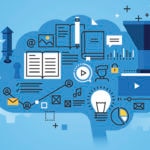How can behavioral economics help consumers
We humans have a history of finding faster, simpler, more efficient ways of doing things. Over time, we’ve sped up every process from building a car to ordering a pizza online. So it’s really no surprise that we’ve also established thought processes to help us wade through all the information we encounter and make decisions more quickly.

Many of these thought processes are rooted deep in our past -- like our present bias underlying our desire for instant gratification -- while others have evolved to simply conserve brain cells: we consistently buy the same peanut butter rather than evaluating each option every time we shop or drive the same route to work everyday (sometimes arriving with no memory of how we got there).
Gels: Financial institutions that study behavioral economics -- like BBVA -- can use this premise to help consumers make more conscious, better informed financial decisions.
When those shortcuts and beliefs get in the way of our own best interests, though, it can be difficult to sidestep them. “When our decision making becomes subconscious, we sometimes need what we call a nudge, or an architecture of choices that simplifies decision making. For example, we might flag one option as ‘most common’ or ‘most frequently chosen by people in your situation’,” said Michelle Gels, Behavioral Economics Discipline Head at BBVA USA. “Financial institutions that study behavioral economics -- like BBVA -- can use this premise to help consumers make more conscious, better informed financial decisions.”
There are three main categories that can impact decision making: short cuts, beliefs, and preferences. Each category presents the possibility for irrational or inaccurate decisions, as well as potential prompts to help us make better ones, starting with shortcuts:
- Cognitive Overload is the paralysis we all feel when we are overwhelmed with too much information or too many options to choose from. For example, a consumer who’s faced with too many variables in preparing a retirement plan may opt to delay the decision. Financial institutions -- in fact, retailers of any type -- can help consumers move forward by offering fewer, more relevant choices or by grouping options into categories.
- Framing allows consumers to make decisions based on the way information is presented. When a consumer can easily calculate how much savings is required to fund their post-retirement lifestyle, it provides a reference point. Their current savings balance then becomes more than just a number. They are able to frame their progress and more clearly see whether they are comfortable where they are or should increase their savings.
- Social Influence is similar to framing, in that it provides context to abstract numbers compared to other people. Understanding that 25 percent of Americans have saved more for retirement than you have provides contextual information that makes your own savings information more relevant.
Gels: Having a clear understanding of the shortcuts consumers use in making financial decisions is changing the way we present information to our customers.
“Having a clear understanding of the shortcuts consumers use in making financial decisions is changing the way we present information to our customers,” Gels said. “We are actively streamlining web content and application options to provide clear options to consumers. Our next step is to begin offering contextual information and tools that make financial information more useful and more meaningful.”
Other behavioral economics premises are based on consumer beliefs -- the biases that impact the choices we make -- and consumer preferences, both of which impact consumer decision making. Bookmark or stay tuned to bbva.com to read more about these premises in the next upcoming article in our behavioral economics series.
This article is the second in a series on behavioral economics. Click below to read other articles in this series: